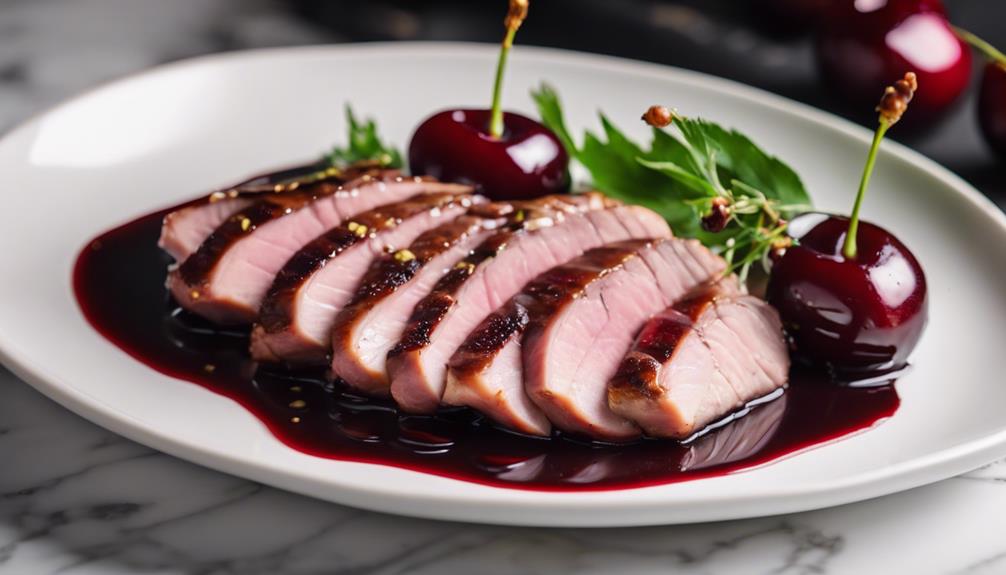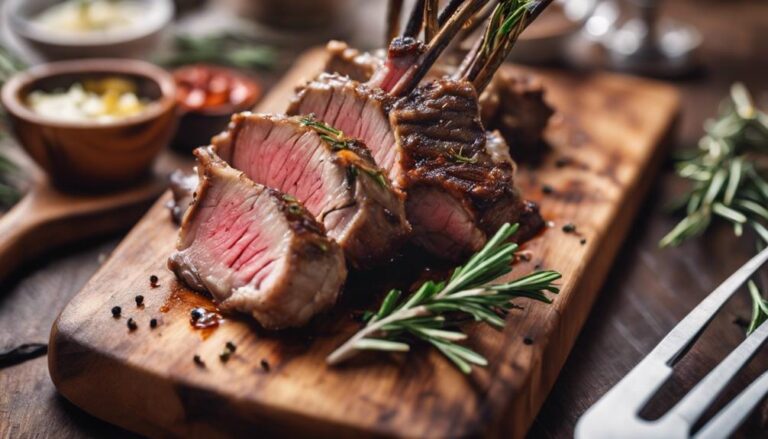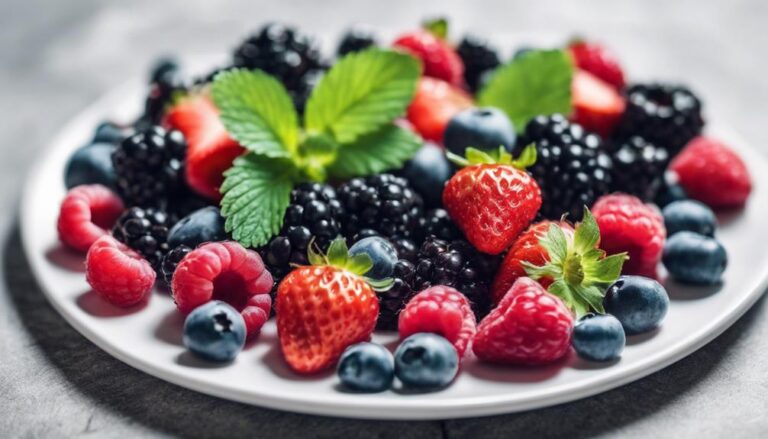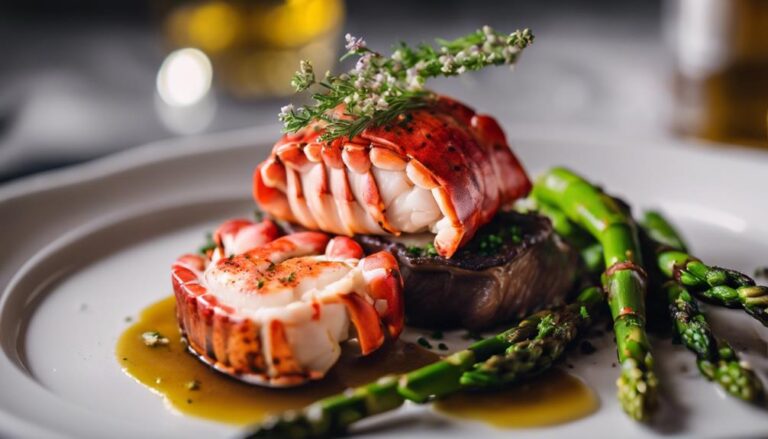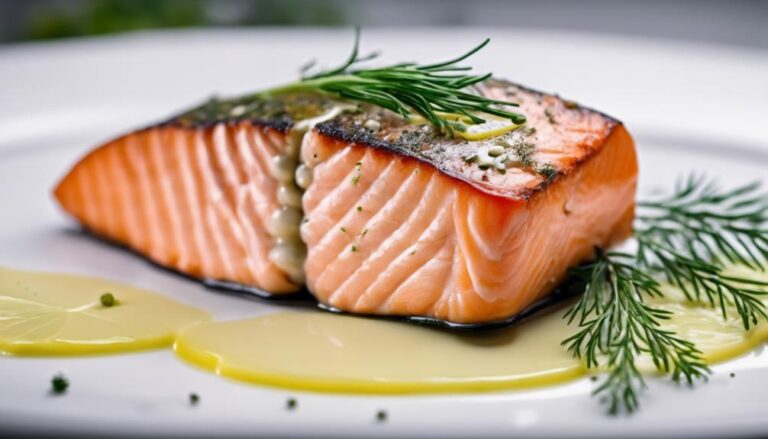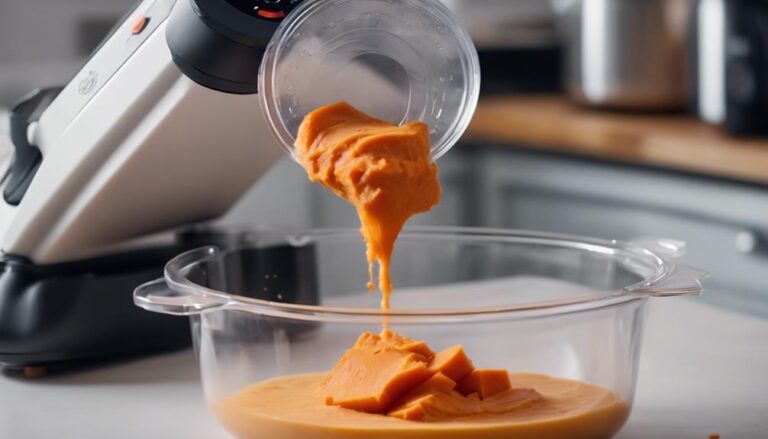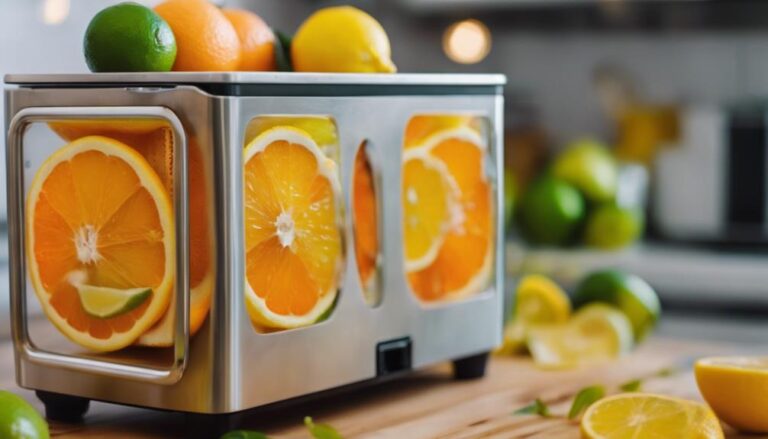Sous Vide Duck Breast With Cherry Sauce
Achieve culinary perfection by preparing sous vide duck breast with a delightful cherry sauce. Start with high-quality duck breasts and seasonings. Guarantee reliable cooking equipment and master the searing process for best results. Explore sous vide benefits like precise cooking and flavor retention. Incorporate marinating, duck confit, and precise temperature control techniques. Benefit from accurate cooking times and achieving ideal doneness. Elevate your cooking with this gourmet dish.
What You Will Learn Here
- Sous vide cooking ensures precise and consistent doneness for juicy duck breasts.
- Choose rich and complementary seasonings to enhance the flavor profile of the dish.
- Searing the duck breasts after sous vide cooking adds a crispy exterior for textural contrast.
- Cherry sauce adds a sweet and tangy element that complements the rich duck meat.
- Perfecting the sear ensures a beautifully colored and flavorful dish.
Sous Vide Origins
Sous vide is a cooking method that involves vacuum-sealing food and cooking it in a water bath at precise temperatures. The technique has a rich history and has evolved over time, leading to culinary innovations and the creation of tender, flavorful dishes.
Understanding the origins of sous vide can provide insight into how this cooking style has become a staple in modern gastronomy.
Sous Vide History
Originating in France in the 1970s, the sous vide cooking technique revolutionized the culinary world by providing precise temperature control for cooking food in vacuum-sealed bags. This method was initially developed by Georges Pralus, a French chef, as a way to maintain the integrity of foie gras.
The term 'sous vide' itself translates to 'under vacuum' in French, highlighting the key aspect of this cooking style—sealing ingredients in airtight bags to cook them in a water bath at consistent low temperatures.
Sous vide gained popularity not only for its ability to produce tender and evenly cooked dishes but also for its convenience and flexibility in the kitchen. Chefs around the world soon adopted this technique, recognizing its potential to elevate various ingredients and dishes to new levels of quality and taste.
Over the years, sous vide has evolved from a niche method in high-end restaurants to a more accessible cooking approach utilized by home cooks and culinary enthusiasts alike. This evolution has led to a wide range of sous vide recipes and innovations that continue to shape modern gastronomy.
Technique Evolution
The evolution of sous vide cooking techniques has seen significant advancements since its initial development in the 1970s, shaping the way chefs approach precision cooking methods today. Originally created as a method for preserving food, sous vide has transformed into a culinary technique celebrated for its ability to enhance flavors and textures.
In the early days, sous vide was mainly used in industrial food production due to the specialized equipment required. However, as technology progressed, the technique became more accessible to home cooks and professional chefs alike. With the introduction of affordable sous vide machines and precise temperature control devices, the method gained popularity and began to revolutionize the way dishes were prepared.
Chefs started experimenting with different cooking times and temperatures to achieve optimal results, leading to a deeper understanding of how sous vide can elevate dishes to new heights. The evolution of sous vide techniques continues to push the boundaries of culinary innovation, inspiring creativity and precision in the kitchen.
Culinary Innovation
Since its inception, the culinary technique of sous vide has continually pushed the boundaries of traditional cooking methods, revolutionizing the way dishes are prepared and flavors are enhanced.
This innovative method traces its origins back to the 18th century when physicist Sir Benjamin Thompson discovered that food cooked in a vacuum-sealed bag retained its moisture and flavor. Fast forward to the 1960s when French chef Georges Pralus refined the technique, popularizing it in professional kitchens worldwide.
Sous vide, which means 'under vacuum' in French, involves cooking ingredients at precise temperatures in a water bath, resulting in evenly cooked dishes with enhanced taste and texture. This method has gained traction among home cooks and Michelin-starred restaurants alike, showcasing its versatility and consistency in creating restaurant-quality meals at home.
Key Duck Breast Components
For the perfect sous vide duck breast, focus on selecting high-quality ingredients and precise cooking times. When it comes to preparing a delightful duck dish, the key components play an important role in achieving a flavorful and tender outcome. Here are four essential elements to keep in mind:
- Duck Breast: Choose fresh, high-quality duck breasts with a generous layer of fat. Look for plump, well-shaped breasts that are evenly colored with a thick fat cap. The quality of the meat will greatly impact the final taste and texture of your dish.
- Seasonings: Opt for a blend of seasonings that complement the rich flavor of duck. Common choices include salt, pepper, garlic, thyme, and rosemary. Season the duck breasts generously before vacuum-sealing them for sous vide cooking.
- Cooking Equipment: Invest in a reliable sous vide machine to maintain precise temperature control during the cooking process. A vacuum sealer is also essential for sealing the duck breasts in airtight bags before submerging them in the water bath.
- Searing Method: To achieve a crispy skin on the duck breast after sous vide cooking, a hot skillet or searing torch is necessary. Searing the duck quickly on high heat will help render the fat and create a delicious golden crust without overcooking the meat.
Duck Breast Delight
When it comes to Duck Breast Delight, you're in for a treat with succulent duck breast recipes that will tantalize your taste buds.
Try out the cherry-glazed duck breast for a burst of sweet and savory flavors that complement the richness of the meat.
For a unique twist, explore the world of duck confit recipes that showcase the versatility of this delectable ingredient.
Succulent Duck Breast Recipe
Indulge in the rich flavors of succulent duck breast with this delightful recipe. Follow these simple steps to create a mouthwatering dish that will impress your guests:
- Prepare the Duck Breast: Begin by scoring the skin of the duck breast in a crisscross pattern, being careful not to cut into the meat. Season the breast generously with salt and pepper, ensuring to coat both sides evenly.
- Sear the Duck Breast: Heat a skillet over medium-high heat and place the duck breast skin-side down. Sear for about 6-8 minutes until the skin is crispy and golden brown. Flip the breast and sear the other side for an additional 2-3 minutes.
- Finish Cooking: Transfer the duck breast to a preheated oven and roast at 400°F for 8-10 minutes, or until it reaches your desired level of doneness.
- Rest and Slice: Allow the duck breast to rest for a few minutes before slicing it against the grain. Serve with your favorite sides and enjoy the succulent flavors of this delicious dish.
Cherry-Glazed Duck Breast
Enhance the succulent flavor of duck breast by glazing it with a delightful cherry sauce. Imagine the rich, tender duck breast perfectly cooked and coated with a sweet and tangy cherry glaze, creating a harmonious blend of flavors that will tantalize your taste buds.
Here are four essential tips to create the perfect cherry-glazed duck breast:
- Selecting the Duck Breast: Choose high-quality duck breast with good marbling for the best results.
- Preparing the Cherry Sauce: Simmer fresh cherries, sugar, and a splash of balsamic vinegar until the mixture thickens into a glossy sauce.
- Glazing the Duck Breast: Brush the cherry sauce over the seared duck breast and let it caramelize slightly under the broiler for a beautiful finish.
- Serving Suggestions: Pair this dish with roasted vegetables or a simple salad to complement the richness of the duck and the sweetness of the cherry glaze.
Unique Duck Confit Recipe
For a delightful twist on traditional duck breast recipes, consider trying out this unique Duck Confit Recipe (Duck Breast Delight). If you're looking to impress your guests with a flavorful and tender dish, this recipe is a perfect choice.
Here are four key steps to creating this Duck Breast Delight:
- Preparation: Start by seasoning the duck legs with salt, pepper, and your choice of herbs. Let them marinate for a few hours or overnight in the refrigerator for maximum flavor.
- Cooking: Slowly cook the duck legs in duck fat at a low temperature for several hours until the meat is tender and falls off the bone. This slow cooking process is what gives duck confit its unique texture and taste.
- Crisping: Once the duck legs are cooked, crisp up the skin by searing it in a hot pan until it's golden and crispy. This step adds a delightful crunch to the dish.
- Serving: Serve the duck confit hot with a side of roasted vegetables or a fresh salad for a delicious and elegant meal that will surely impress your dinner guests. Enjoy your culinary masterpiece!
Sous Vide Technique Insights
When it comes to sous vide cooking, you'll benefit from precise temperature control, ensuring your duck breast comes out perfectly cooked every time.
Keep in mind some temperature control tips for the best results, and consider the suggested cooking times for that tender, juicy duck breast.
Sous Vide Benefits
Discover the precision and consistency that sous vide cooking brings to your culinary creations. Sous vide, a cooking technique that involves vacuum-sealing food in a bag and cooking it in a water bath at a precise temperature, offers a range of benefits that elevate your dishes. One of the main advantages of sous vide is the ability to achieve perfect doneness every time. By controlling the temperature with precision, you can guarantee that your duck breast, steak, or vegetables are cooked exactly to your liking – no more overcooked or undercooked meals.
Additionally, sous vide cooking helps to retain the natural flavors and juices of the ingredients. Since the food is sealed in a bag during the cooking process, all the flavors and nutrients are preserved, resulting in tender and flavorful dishes. This method also allows for easy meal prep, as you can cook in advance and simply finish off the dish with a quick sear or garnish before serving.
With sous vide, you can impress your guests with restaurant-quality meals right in your own kitchen.
Temperature Control Tips
Utilizing precise temperature control is vital for mastering the sous vide technique and achieving consistent results in your culinary creations. To guarantee accuracy, start by calibrating your sous vide machine according to the manufacturer's instructions. This step is essential for maintaining the desired temperature throughout the cooking process. When setting the temperature for your duck breast, consider the desired level of doneness. For a tender and medium-rare result, aim for around 135°F (57°C). If you prefer a more well-done texture, increase the temperature accordingly.
Another important tip is to use quality sous vide bags that are designed for cooking. These bags are necessary for retaining the juices and flavors of the duck breast while cooking. Make sure to remove as much air as possible from the bag before sealing it to ensure proper heat transfer. Throughout the cooking process, monitor the water level in the sous vide container to prevent fluctuations in temperature. By following these temperature control tips, you can elevate your sous vide duck breast with cherry sauce to a gourmet level.
Cooking Time Suggestions
For best results in sous vide cooking, make sure you follow precise cooking time suggestions to elevate your culinary creations.
The cooking time for duck breast can vary depending on the desired doneness and thickness of the meat. As a general guide, for a medium-rare duck breast, aim for a cooking time of 1.5 to 2 hours at 135°F (57°C). If you prefer your duck breast more on the medium side, increase the cooking time to 2 to 2.5 hours at the same temperature.
Thicker cuts may require an additional 30 minutes to guarantee even cooking. It's important to maintain a consistent water temperature throughout the cooking process to achieve the desired results.
Remember that sous vide cooking is a precise method that allows you to control the outcome with accuracy. By following the recommended cooking times closely, you'll make sure that your duck breast is perfectly cooked to your liking, tender, and full of flavor.
Final Thoughts
In conclusion, consider the overall balance of flavors in your sous vide duck breast with cherry sauce for a delightful dining experience. The tenderness of the duck breast achieved through sous vide cooking method should be complemented by the rich and slightly tangy notes of the cherry sauce. Make sure that the sauce has reduced sufficiently to intensify the flavors without overpowering the natural taste of the duck.
When serving the dish, think about pairing it with sides that can enhance the meal further. A simple arugula salad dressed lightly with balsamic vinaigrette can provide a revitalizing contrast to the richness of the duck and cherry sauce. Additionally, roasted potatoes or a creamy polenta can offer a comforting element to the plate.
As you enjoy your sous vide duck breast with cherry sauce, take note of the texture of the meat and the way it pairs with the sweet and savory sauce. The sous vide method should have yielded a perfectly cooked duck breast that's juicy and tender. The cherry sauce, with its deep flavors and hint of sweetness, should elevate the dish to a memorable culinary experience. Bon appétit!
Frequently Asked Questions
Can I Use Frozen Cherries for the Cherry Sauce?
Yes, you can use frozen cherries for the cherry sauce. Just make sure to thaw them properly before cooking. Frozen cherries can work well in sauces and offer a convenient option when fresh cherries are not available.
What Other Fruits Can Be Paired With Duck Breast?
When pairing fruits with duck breast, consider options like orange, raspberry, fig, or cranberry. These fruits complement the rich flavor of duck and offer a nice contrast. Experiment to find your favorite combination!
How Can I Prevent the Duck Breast From Overcooking?
To prevent the duck breast from overcooking, make sure to monitor the temperature carefully during cooking. Use a thermometer to check the doneness and remove the duck from heat promptly to guarantee it stays perfectly cooked.
Can I Substitute Duck Breast With Chicken?
Yes, you can substitute duck breast with chicken in the recipe. Make sure to adjust the cooking time accordingly, as chicken needs to be cooked to a higher internal temperature than duck. Enjoy your culinary experiment!
Is It Possible to Sous Vide Duck Breast Without a Vacuum Sealer?
Yes, you can sous vide duck breast without a vacuum sealer. Simply use the water displacement method. Place the duck breast in a resealable bag, submerge in water to push out air, seal it, and then cook it sous vide.
Conclusion
To sum up, sous vide duck breast with cherry sauce is a delightful dish that combines tender duck breast with a sweet and tangy sauce.
The sous vide technique guarantees the meat is perfectly cooked and full of flavor.
This recipe showcases the versatility and precision of sous vide cooking, allowing you to impress your guests with a restaurant-quality meal at home.
Try this dish for a sophisticated and delicious dining experience that will leave everyone wanting more.
